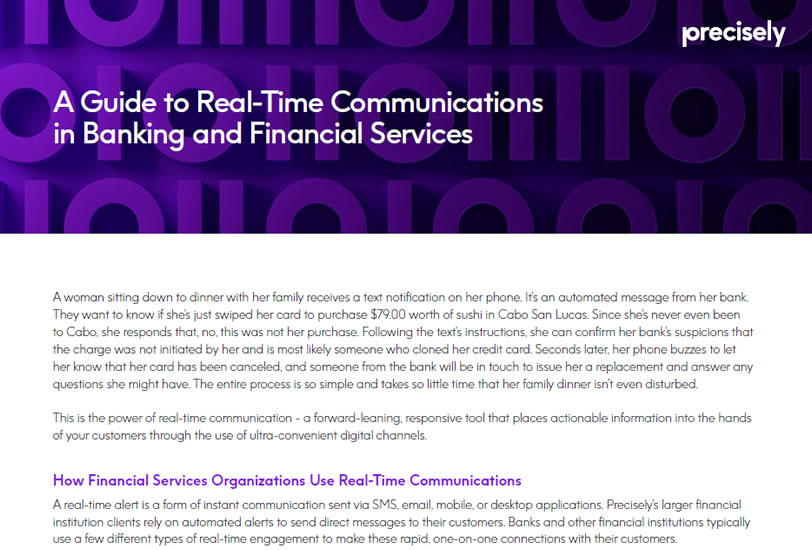White Paper
A Guide to Real-Time Communications in Banking and Financial Services
A woman sitting down to dinner with her family receives a text notification on her phone. It’s an automated message from her bank. They want to know if she’s just swiped her card to purchase $79.00 worth of sushi in Cabo San Lucas. Since she’s never even been to Cabo, she responds that, no, this was not her purchase. Following the text’s instructions, she can confirm her bank’s suspicions that the charge was not initiated by her and is most likely someone who cloned her credit card. Seconds later, her phone buzzes to let her know that her card has been canceled, and someone from the bank will be in touch to issue her a replacement and answer any questions she might have. The entire process is so simple and takes so little time that her family dinner isn’t even disturbed.
This is the power of real-time communication — a forward-leaning, responsive tool that places actionable information into the hands of your customers through the use of ultra-convenient digital channels.
How Financial Services Organizations Use Real-Time Communications
A real-time alert is a form of instant communication sent via SMS, email, mobile, or desktop applications. Precisely’s larger financial institution clients rely on automated alerts to send direct messages to their customers. Banks and other financial institutions typically use a few different types of real-time engagement to make these rapid, one-on-one connections with their customers.
Balance
Consumers like to be informed if their accounts dip below certain thresholds. Banks can send automated notifications to their customers based on customizable settings with on-demand alerts, so customers always know their current balance. Because their customers are alerted when their accounts fall below a designated floor, individuals are less likely to overdraft their accounts. They can even adjust their spending habits based on this helpful service. Providing your customers with these personalized insights improves the experience and drives customer satisfaction and trust. For example, a Digital Banking Report survey found that 47% of consumers want their bank to provide proactive guidance based on their income, expenses, and savings.
Purchases
Much like in our example above, customers appreciate the extra convenience of being notified about large or unusual purchases made on their accounts. With criminal fraud activity on the rise, consumers expect financial services companies to be on the ball with instant alerts so customers can confirm or dispute unusual charges as they arise. Real-time purchase alerts help consumers feel safe knowing that someone is monitoring their accounts for criminal activity like imposter scams and fraudulent online shopping – the top two categories of consumer fraud reported to the FTC.
Deposits and Withdrawals
With more digital channels to connect with providers than ever before, on-the-go money management is rising in popularity with consumers. Instantaneous alerts that let your customers know when a check has been deposited or when money has been withdrawn are now a normal part of the personalized digital banking experience. When more than one individual manages an account, this feature is helpful for all account holders to see the inflow and outflow by other users.
Read this white paper as it explores on-demand connections to customers and how to provide enhanced customer experiences through digital channels.
